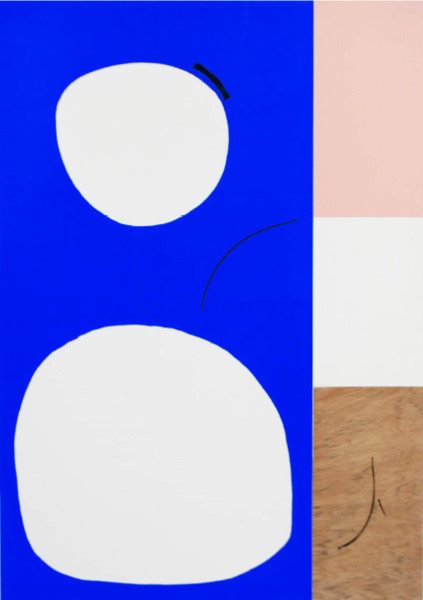
Photo: Courtesy Bid Project
Jannis Kounellis Composizione (2003). Installation view at Matteo Lampertico, Arte Fiera 2016.
Photo: Hili Perlson.
When describing an art fair, using the attribute “regional” is hardly a neutral modifier, often meant as an impugning comment on the quality of the art on offer and the fair’s reach in terms of collectors, institutions, and exhibitors. However, Arte Fiera in Bologna, which opened its 40th anniversary edition this past Friday, is a special case.
Over the years, the fair has been increasingly adopting a local appeal, with Italian galleries making up most of the 190 exhibitors. Given the rising popularity at recent auctions of artists such as Alberto Burri, Lucio Fontana, Afro, and Agostino Bonalumi to name a few, bolstered by major museum shows, it comes as no surprise that post-war Italian art was celebrated across the fair’s three halls, with Burri’s Plastica Rosa (1966) at Mazzoleni, priced at €4 million, making one of the fair’s most expensive highlights.
But exhibitors expressed mixed feelings about the fair’s locality. “We don’t make any new international contacts at Arte Fiera,” Roberto Santoro, of the Milanese Matteo Lampertico gallery told artnet News. “Most clients come here through our invitation, and big galleries have stopped coming to the fair.” The gallery had a selection of works by Fontana, Enrico Castellani, and Jannis Kounellis, but declined to discuss prices, while reporting some sales on opening day.
Arcangelo Sassolino, Nucleo (2016). Installation view at Galerie Continua, Arte Fiera 2016.
Photo: Hili Perlson.
Gallerist Eduardo Secci, whose gallery is based in Florence, considers the fair’s local focus a plus. “It’s the best Italian art fair; it’s becoming more local every year, but that’s the attraction for us. It’s less contemporary and less international, but the best Italian collectors come,” he told artnet News. The gallery also showed works by recently rediscovered Bernhard Rüdiger, and paintings by Alfredo Pirri rendered with feathers on plexiglass, priced at €34,000 (including VAT). On day one, the gallery sold a Pirri painting from 2006 for €18,000.
At Galleria Continua, which has a branch in Italy, in addition to Beijing, Les Moulin, and Havana, the focus was on a younger generation, with sculptural works by Arcangelo Sassolino, who currently has a show at the Contemporary Art Museum St. Louis, performing well for at prices ranging from €15,000 to €35,000.
Works by Fabrizio Prevedello, installation view at Cardelli & Fontana, Arte Fiera 2016.
Photo: Hili Perlson.
Arte Fiera’s artistic directors, Giorgio Verzotti and Claudio Spadoni, invited exhibitors to spotlight artists under 40 alongside established names, mid-career artists, and “rediscoveries.” At the booth of Turin-based gallery Cardelli & Fontana, this focus meant a presentation dedicated to 44-year-old artist Fabrizio Prevedello, who studied in Carrara, and whose elegant, poetic sculptures often utilize marble quarried there. With prices ranging between €4,000 – €15,000, Prevedello was one of the most exciting discoveries at the fair.
Another standout at one of the two main halls was a display by Giorgio Maffei, who specializes in rare books on 20th century art. The curated booth offered first-editions of art books, monographs, and printed ephemera by women artists only. The 1947 edition of Du Cubisme—with an addendum to the 1912 first edition by authors Albert Gleizes and Jean Metzinger—was the most expensive item on offer, priced at €7,000. The cheapest, at €50, was a copy of W Magazine‘s 2010 art issue, with a nude Kim Kardashian on the cover, her sex concealed by a text work by Barbara Kruger.
Giorgio Maffei gallery at Arte Fiera 2016.
Photo: Hili Perlson.
Galleria Open Art showed a mixed booth featuring American artists Paul Jenkins and Conrad Marca-Relli (with the most expensive work priced at €200,000), Italians Walter Fusi and Toti Scialoja (ranging from €40,000-€50,000), and Czech writer and artist Jiří Kolář. A 1967 collage by Kolář was reported sold on day one, with prices for his works ranging from €6,000 for small works on paper to €36,000 for photo-emulsion canvases. They also sold a Marca-Relli, a work by Fusi to a museum in Karlsruhe, and two Jenkins to private collectors.
Sergio Sarri, The Shower (1970). Installation view at Robilant & Voena, Arte Fiera 2016
Photo: Hili Perlson.
Robilant & Voena have done well with post-war Italian art last year, and have opted here for a booth dedicated to Sergio Sarri’s nightmarish, cartoonish metaphors on man’s relation to machines, to mark the 70th anniversary of his series “Mitomacchina” (1966-1979). The sleek, hard-edged paintings’ multiple frames have certainly stood the test of time, and manage the balance between their “retro” appeal and a crisp timelessness of style. Sarri is still active and, at 78, still comments on our relation to technology, with newer paintings and drawings on offer in the back room. His newer works range from €8,000-20,000, while the historical paintings go for €25,000-50,000–though many are in private collections, and not for sale.
Henry Jackson Newcomb.
Photo: Courtesy Bid Projec.t
Arte Fiera is not the foremost fair for emerging artists and with only a dozen exhibitors, the section titled “New Proposals” is rather modest. Here, Bid Project stood out with a mixed booth by younger artists including Henry Jackson Newcomb, Pedro Matos, Sreshta Rit Premnath, and Valerio Rocco Orlando, and reported healthy interest at the end of day one.
The fair’s 40th anniversary was celebrated with a city-wide program of openings and events, and the city’s two main art museums, the MAMBO and the Pinacoteca, held a two-part exhibition that traces four decades of Italian art in relation to the fair, and museum acquisitions made there. The weekend saw 200,000 visitors taking over the city, and tickets to the national premiere of Matthew Barney’s River of Fundament has been sold out for weeks. With such lively local interest in the Italian scene, Arte Fiera’s regional approach seems to be working just fine.